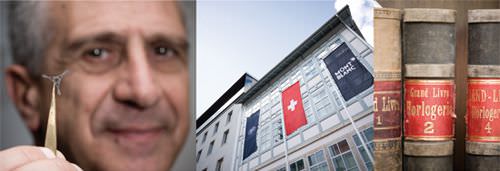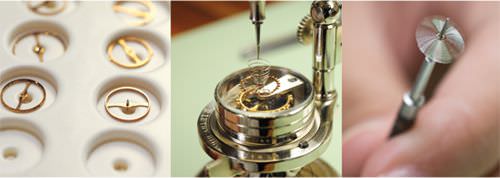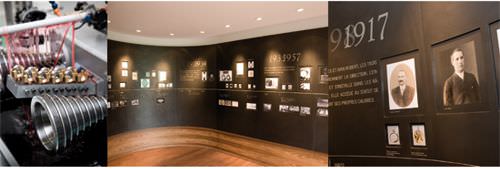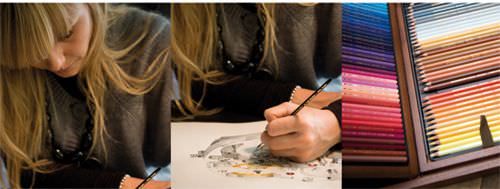In today’s watchmaking world, most companies strive to find the most modern and precise ways of making movements and watches, including new materials, new dial displays, cutting edge, never-before-seen movements and more. There is so much push towards ‘new watchmaking’ that it’s a pleasure to walk through the doors of the Institut Minerva de Recherche en Haute Horlogerie - in English, the Minerva Institute for Research in Fine Watchmaking - where time has stood still, in a good way.
The Minerva Institute, which was purchased by the Richemont Group in 2004, is one of the few manufactures that has been producing watches and movements continuously since its inception. Minerva, a famous name in movements, was founded in 1858 in the town of Villeret, Switzerland. Once a bustling centre of watchmaking, now only two companies remain in Villeret – Minerva on the main street and Longines down in the valley.
The purchase by Richemont has allowed Minerva to remain committed to its roots – making the finest mechanical movements, using traditional production methods mixed with modern ways of thinking and manufacturing.

The history of Minerva
The company that would become Minerva was founded in Villeret and was initially called H & C Robert Co. Included among its trademarks was the Minerva brand (as well as Arrow and others).
H & C Robert started out as an assembler, buying pieces from companies and making their own pocket watches. At the end of the 19th century, H & C Robert was an established watchmaker, producing its own movements and cases and had all the skills for complete watch production. In fact, by 1902, H & C Robert was producing its own, in-house pocket watch movement with a cylinder escapement. The company went on to develop a number of calibres and gained quite a bit of fame in the watch industry in Switzerland and abroad.
In 1929, the company was renamed Minerva S.A. and then was sold in 1935 to Charles Haussener and Jacques Pelot, who had both been workers at Minerva since 1921. They continued Minerva’s concentration on small pro-duction runs of exclusive, mechanically complicated watches. Production has continued, uninterrupted, to the present day.
In 2007, Richemont stepped in and preserved this jewel of Swiss watchmaking, making it possible to continue the traditional methods of production.

Montblanc and Minerva
Both Montblanc and Minerva Villeret are owned by the Richemont Group. How did Minerva end up being exclusively managed by Montblanc? According to Alexander Schmidt, Business Director, Institut Minerva de Recherche en Haute Horlogerie, Villeret 1858, each of the Richemont brands had an equal opportunity to present to the Richemont board the reasons why they should work with Minerva. Out of all of these presentations, the presentation by Montblanc was the most impressive, and was successful.
Now, Minerva’s complete production, about 250 timepieces a year, is dedicated to Montblanc. Immediately, this has made Montblanc a player in high horology, something that had been part of the brand’s mission for quite some time.
“It is a unique chance to have a complete manufacture, where you can develop everything, with designers, constructors, watchmakers and artisans, which gives us great oppor-tunities, and you learn how these pieces get created, like it was in the past,” explains Schmidt. “It’s great to work with the passion of these people. For me, it’s a complete new story for Montblanc and it is something on which we can really build Montblanc’s image as a watchmaking brand.”
Montblanc’s first order of business was to renovate the old buildings – there were three, two original buildings on each side and a central building that had burnt down in the 1970s and was rebuilt in the then-modern style. Montblanc wanted to build a facility that would reflect the company’s respect for tra-dition, so the older outside buildings were reno-vated but as much of the old buildings as poss-ible was kept (windows, tiling, floor levels, etc.), while the middle building was redone completely to match the style of the other two. Now, the Minerva facility is a maze of floors that don’t match up from building to building, but this only adds to the charms and reinforces the character of the original facility, on display to even the most casual of visitors.
“When I first came here, in January 2007, on a very snowy day, we were standing outside in the streets of Villeret in 2007, but inside it was like going back in time,” Schmidt remembers. “The facility had the aura of living history and we wanted to keep that sense. We didn’t really renovate, we brought the old parts out again. We brought out all the old floors, restoring them, we kept the old windows, we kept the scars on the wall, all we could keep we kept. The concept here is to maintain tradition and help it develop. We have the old building, but we also have the penthouse on top, which represents the future.”
The penthouse is a modern glass structure that holds an exhibition on the history of Minerva, has a space for meetings, corporate lunches and brand presentations and has a small library filled with the general ledgers from Minerva – huge, hand-written books that list all the products and customers throughout the company’s history. Some of the most famous names in watchmaking can be found in these pages, as clients of Minerva, which makes for quite interesting reading.
The way the facility was redone matches the way that Montblanc and Minerva are committed to producing watches – the old fashioned way. When Richemont purchased Minerva, on the premises were a lot of old machines for producing movement parts, engraving, finishing and more. Minerva has kept these old machines in operation and uses them in the production of its watches wherever possible. Minerva is a unique mixture of cutting edge technology, CNC machines and computer-aided design, and centuries-old hand work.

The watch production
Minerva is one of the few companies in the entire industry that has the ability to make every piece that goes into its watch movements, including the balance spring. Minerva, in fact, buys the raw balance wire, then puts it through several operations to thin it by 15 percent to the right size, which is then hand-twisted into a spiral, then tempered, and then the terminal curve is hand done by one woman, Monique WyssmÜller. This is indicative of the attention to detail that goes into every step of the Minerva watches and justifies their price, which starts at 30,000 Euros and goes up to over 200,000 Euros for the tourbillon.
Sure, there are cheaper and more efficient ways to do it, but Minerva doesn’t take the cheap or easy way in anything the company does.
“The collection was called Villeret 1858, but that has changed,” Schmidt explains. “Now, on the dial, it will only have Montblanc, and Minerva Villeret is engraved on the movement. For me, this really pictures the cooperation - it’s a Montblanc watch with a Minerva heart. If it wasn’t for Minerva, Montblanc wouldn’t have this movement competence, but if it wasn’t for Montblanc, Minerva would not exist as it is today.”
Currently, Minerva only makes about 250 watches a year and Schmidt would like to see that number increase a little bit. “It’s difficult to increase too much, you can’t scale it to a much higher level,” he admits. “I don’t think we will ever be able to do more than 400 watches. Every piece is a piece of art and must stay exclusive. It’s a story of value to the collector. We restrict ourselves to make only 288 examples of every movement (288 comes from the fact that we do our movement in the traditional movement lot size of 12, 12 x 12 is 144 x 2 is 288). Every movement, after two or three years, will have to stop.
“Currently, we have eight movements in production,” he continues. “We commit ourselves to present a new movement every year, and this is not a module put on an existing movement, it is always an integrated movement. In 2007, we introduced the new collection with existing movements from Minerva. In 2008, we introduced two new movements, and in October of that year, for the 150th anniversary, we introduced the tourbillon. Then, in 2009 we introduced the Chronograph Regulator.”
All the movements are made in Villeret and they are all Minerva calibres, developed and made by Minerva. The development is never outsourced.
None of this could be done without the people working for Minerva, as so much of the work is done by hand. Currently, 37 people work at Minerva, up from 17 when Richemont bought the concern. “The central person was Demetrio Cabiddu and he stayed on as the technical director,” Schmidt details. “We have others who joined us from completely different backgrounds, and they came here because here you can do things you can’t do anywhere else. Hugo Lopez is the head of our technical development and he was the head of the Richemont development department. He joined us in 2007 and he has completely bought into our philosophy. You have to share the spirit of Minerva, or this kind of work can drive you crazy.”
Montblanc’s normal line of watches consists of industrialized production, while the Minerva watches are the high-end of Montblanc’s range, emphasizing artisanal processes and production methods.
“In the field of watchmaking, you have a very broad range of prices,” Schmidt explains. “If you compare what we do here at Minerva with industrialized watchmaking, it is much more expensive. But, the finishing and details are different. It’s not that one is better than the other, but they both have their reason for being. We do institutionalized production in Le Locle, at the Montblanc facility.”

The customer
As with other very high-end, limited production brands, Minerva is doing well in this economy, because there is no way they can make enough watches to satisfy the demand.
According to Schmidt, there are three customer groups. “The first is made up of the complete Montblanc fans, who love all of our creations,” he details. “The second group is the real watch aficionados. With the Villeret concept, we have something unique and it is perfect for these collectors, they know how much work goes into it, they understand the finishing and artistry. The third group is comprised of the people who want something that no one else has.”
As a unique offering, every Montblanc Minerva watch comes with a set of lithographs presented in a leather-bound case: including historic depictions of the old Minerva manufacture, landscape impressions of the Jura mountains, illustrations of the watch movements and a lithograph of the watch purchased. This last lithograph is completely unique as it includes the watch‘s serial number, its number in the limited edition, and the handwritten signature of master watchmaker Cabiddu.
Walking into the Minerva Institute is a little like stepping back in time, watching artisans at work hand crafting each and every watch. Minerva is a slice of 19th century watchmaking thriving in the 21st century.
Source: Europa Star August-September 2009 Magazine Issue





